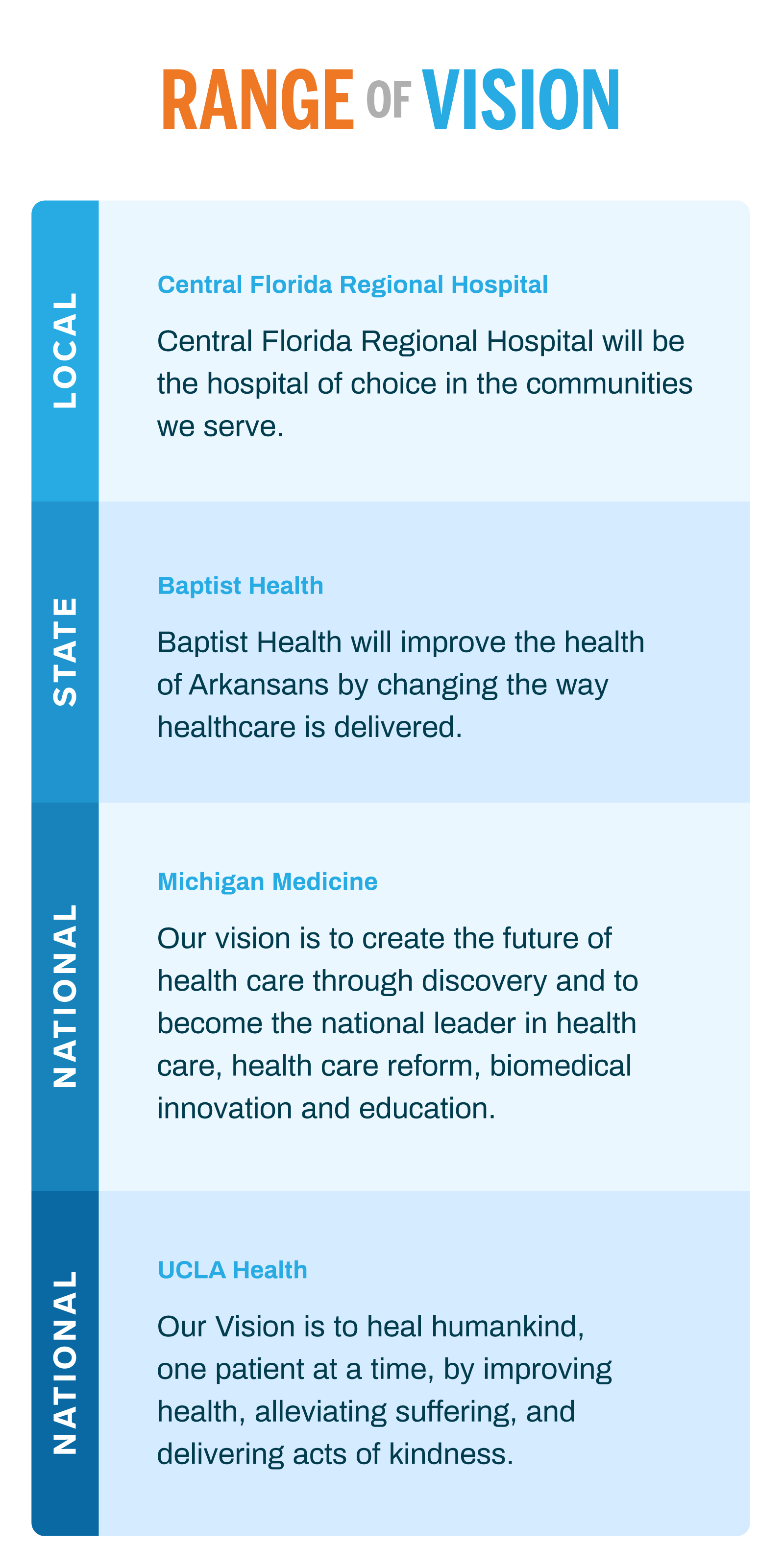
The Alluring, Thrilling, and Overwhelming Risk of Vision
Vision or visionary?
You don’t have to be a visionary in the common understanding of the word to have a vision. Cliché 21st Century visionaries: Steve Jobs, Oprah Winfrey, Elon Musk, Alice Waters. Meanwhile, a school principal who wants to see her students’ college attendance rates go from 70 percent to 100 percent won’t be listed next to those four on Wikipedia. But she has vision.
How insane does a vision have to be – to be considered a vision?
A vision doesn’t have to fit a set template. It should be personal. It should be challenging for the resources you have – but not impossible. A vision is simply a framework for how the corner of the world you can affect should look. A vision, according to Dr. Susan Turney, CEO of Wisconsin-based Marshfield Clinic Health System, “is thinking about and planning the future using one’s wisdom and imagination and creating an opportunity for growth.”
With that framework, a vision could be but doesn’t have to be crazy. Elon Musk has visions for a colony on Mars, for “achieving a sustainable energy economy” and for a lot of other things yet to be shared. Then there’s your friend who has a vision of spending his last days in quiet cabin in the Rockies and leaving his kids a modest inheritance. Senator Bernie Sanders has a vision for an entirely different healthcare system, whereas a hospital CEO may have a vision for the lowest readmission rates in the state.
So, there’s quite a spectrum for vision. But a word of caution about that spectrum: Different industry segments will have different baseline definitions of “vision.” For instance, a national health system will likely use the term in different ways than a health-services startup. The ideas discussed in this issue of Art of Change apply to any leader creating a vision for his or her healthcare organization, but the specifics will vary.

Identifying the Power to Create a Vision
Parents tell their children, “Focus on yourself and what you control. Don’t worry about the other person.” The same is true for organizations. Leaders can be easily distracted by what other health systems are doing instead of how to take advantage of their organization’s unique traits. It’s the differentiators that provide the power to drive change.
Take Geisinger Health System. Dr. Glenn Steele, CEO during a period of revolutionary change at the esteemed Pennsylvania-based institution, says that he was able to execute on his dramatic vision to reshape the relationship between payer and provider because:
- Situationally, the institution was ripe for change after the dissolution of a major merger in the late 1990s.
- Operationally, Geisinger functioned as both payer and provider, and it was uniquely able to leverage its culture, demographics and long-time experience with EHRs to move to a new vision and test new models of care.
The lesson here is that leaders should find their healthcare company’s differentiator and use it as a strength, no matter how simple or small.
Use the Whole, Not the Sum of All Parts
Culturally, Steele knew affecting true change would require an omni-directional communication and decision-making effort – it had to be top down and bottom up. In a recent interview, he emphasized the importance of getting everyone involved. He added that his approach at Geisinger was to largely set the vision and then delegate the tactics to departments and individuals.
“There was a huge amount of balancing what we insisted on in terms of our strategic goals with selecting the details about the actual provision of care,” he said. “I gave discretion to the caregivers to decide what their individual projects would be.”
It’s easy to spout business self-help books and say things like, “Our power to achieve change rests in our collective unity,” and “We’re all in this together.” It’s quite another to act that way on a daily basis. When creating a vision, it is imperative to not only trust your own instincts but to hear and use information from every level of your organization.
“Creating a vision has to be bottom up because it’s the people at the front lines who have the best sense of what’s happening and how care should be delivered,” said Dr. Larry Antonucci, president and CEO of Ft. Myers, Florida-based Lee Health. “You can give framework and they can paint the picture, that’s the ideal scenario.”
Of course, as a leader, it’s easier to simply dictate a decision. Something stronger than “guidance” is necessary at times – that’s why you’re the leader, right?
“In some cases, the world is so different that you then have to create the vision and show them how they fit into it,” Antonucci maintained.
Said Steele, “Once we brought board members and providers in who understood what I was trying to do it was easier to delegate. Initially I said, ‘trust me.’”
Before – and After – the Vision is Cast
Listening
Listening authentically, necessary for creating an effective vision, is another activity in the easy-to-say-hard-to-do category. Anyone can stand on stage and ask for feedback. Yet it takes commitment to want that feedback, to show your people you want it and then to use it to better the organization. The payoff is more than worth the discomfort created by the process of receiving the hard truth.
Antonucci explained that “the values just jump out at you” when a leader walks the floor with his employees. “You can see them living those values on a daily basis,” he said. Values can, in turn, shape the vision (values vision). Or, if they’re not positive values, they can reveal ways that the vision should be used to shift the values (vision values).
Listening also builds trust between employees and leaders, a necessary foundation for making bold decisions.
“People tell you things,” said Turney. “If you listen, you understand their ideas and perspectives and how they value their role. If you don’t have the infrastructure of trust and listening, and if you haven’t sought feedback and collaboration on your mission/vision/values from your entire staff, it’s really hard to be bold and successful.”
Trust borne from listening also helps in those moments when the leader has to come out with hard decisions or to say no. “If you respond effectively, you don’t always have to agree on everything,” said Lee Health COO Dr. Scott Nygaard. “Sometimes it’s just looking for the answer that builds trust. It’s hard to do anything without that.”
And listening can reveal problems that need to be fixed, as told by the people dealing with them.
“People on the ground are pretty good at identifying the problem,” said Nygaard.
Hearing and seeing problems connects leaders to the daily operations of their organization, helping them understand how big decisions from the top affect moment-by-moment activities. A new EHR rollout that looked great on paper could be creating new headaches for clinical staff, prompting an active, listening leader to purchase a software addon from a third-party vendor.
One more bonus to listening: Research has found that effective listening results in “growth and development of followers as well as a more fully functioning, more ethical, higher performing leader.” Everyone wins.
Note: For a fun example of the power of listening, check out the TV show Undercover Boss, in which CEOs and owners of large corporations disguise themselves and work on the front lines of their organizations.
Storytelling
Just as listening involves more than hearing words, communicating involves more than just speaking. Any presentation must land with emotion to be effective, all the more so when the presentation involves a major initiative like casting a new vision. Storytelling, therefore, is never more applicable than when creating and rolling out a new vision.
The power of story applies to all audiences, including those we might assume are driven by data and p-values. Researchers and clinicians need story, too.
“Physicians need to understand the ‘why.’” Nygaard said. “You’re asking them to do something and they ask, ‘What’s in it for me? How does it help me or my patients or my practice?”
Notably, those questions have a data component, too. Nygaard’s emphasized that leaders should connect all the dots – emotional and empirical – to present the full value of a vision.
According to Antonucci, some leaders create a vision but fail to demonstrate where staff and physicians fit into the picture.
“You can’t just paint a pretty picture, you need to paint them into the picture,” he said. “‘Here’s how you fit into this and here’s how your life will be better.’ That’s the beginning of change.”
“Story is absolutely critical,” said Steele. “There are two aspects to that narration: It has to be based on facts that people can relate to, and it has to be based on real chemistry [between narrator and audience.]”
Note: A future issue of Art of Change will focus exclusively on storytelling.
Hard Truths
The term “visionary” can conjure thoughts of a disconnect with laws of the universe. Steve Jobs’ “reality distortion field,” is a prime example.
Similarly, “creating a vision” can be a whitewash for dealing with hard truths. Paint a rosy enough picture and people will forget they’re dealing with a mess. Except that will never work. Leaders must be careful to avoid distorting reality and thereby damaging trust.
On the other hand, connecting measurable outcomes with a vision will add credibility and keep the organization on track.
Steele recalled when he was considering transforming the way Geisinger handled cardiac intervention. “We said we’d protect against the downside,” he said. “If we do things differently we could hurt patients, so let’s figure out the metrics. If they’re moving in the wrong direction we stop the experiment.”
Rose colored glasses? Definitely not, Steele contended.
“We always assumed that 20 to 25 percent of the transformation work we were trying would not work. We’d assume that and ask what it meant for our business model.”
Turney echoed that approach. “You have to talk about your vision, but if you don’t tie it to the strategic steps that we’re taking so that people can correlate the two, advancing the vision will be a big challenge,” she said.
Nygaard shared that anyone can put nice words on a paper, but they have no substance if they’re not measurable and translated into day-to-day reality. Without a benchmark, “How do I know we’re winning or losing against those words?” he asked.
Similarly, leaders shouldn’t hide from the negative. Antonucci periodically checks in with his staff at Lee Health to reflect on why they got into healthcare in the first place. “What’s changed for those who are burned out or fed up?” he asks. Figuring out what broke is the first step in figuring out how to fix it.
And even with a new, bold, exciting vision, not everyone will embrace it. Both Steele and Nygaard spoke of the need to let people leave, whether it’s at the board level or individual clinicians. They may not get it, they may not like it, it may simply be a good time to move on. Leaders can learn from those departures, but they shouldn’t fight it.
Finally, through all of this, leaders need to give and receive grace. “It’s messy,” Nygaard said. “You have to be willing to go through the process with people, give yourself grace and forgiveness along the way. You’re not always going to get it right. Admit it and then stay in the conversation and work through the issues.”
